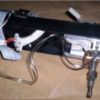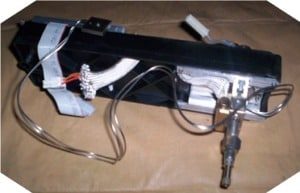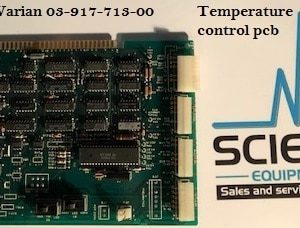
GC Detector, Agilent (HP) 6890 TCD, Refurbished
$1,500.00
GC Detector, Agilent (HP) 6890 TCD (epc control module is extra)
Description
TCD detector, Agilent 6890
The thermal conductivity detector (TCD) detects the difference in thermal conductivity between column effluent flow (carrier gas + sample components) and a reference flow of carrier gas alone; it produces voltage proportional to this difference. The voltage then becomes the output signal to the connected chart recording or integrating device.
The TCD uses a single filament to examine alternately relative thermal conductivities of reference versus column effluent gas streams every 200 msec. At this frequency, the detector is insensitive to thermal drift.
Factors which influence TCD response include the following: Temperature difference between the filament versus the surrounding detector block Flow rate ratio between carrier effluent versus reference gas streams Type of carrier/reference gas used
Caution The TCD filament can be permanently damaged if gas flow through the detector is interrupted while the filament is operating. Make sure the detector is off whenever changes/adjustments are made affecting gas flows through the detector. Likewise, exposure to O2 can permanently damage the filament. Makesure the entire flow system associated with the TCD is leak free and that carrier/reference gas sources are uncontaminated before turning on the detector. Do not use Teflon tubing, either as column material or as gas supply lines, because it is permeable to O2. Since the TCD responds to any compound whose thermal conductivity is different from that of the carrier gas, H1 and He are most commonly used as carrier gases, with H2 giving somewhat greater sensitivity. However, H2 forms explosive mixtures with air (O2), and some components, particularly unsaturated compounds, may react with H2. He produces almost as much sensitivity as H2 and is free from problems of reactivity with sample components or the filament. N2 or Ar may be used but give lower response for most materials; however, they are useful if H2 or He is being analyzed.
Because of its exceptionally high thermal conductivity and chemical inertness, He is the recommended carrier gas: it gives large thermal conductivity differences with all compounds except H2 (considerations necessary in H2 analyses are discussed later). With He as carrier, the TCD exhibits universal response. For propane, the sensitivity limit is about 400 picograms/ml of He carrier gas. The TCD exists in two configurations: either its exhaust vent tube exits at the top of the detector or the exhaust vent tube returns to the inside of the oven for connection to an FID or other device.




